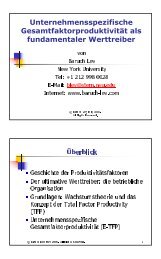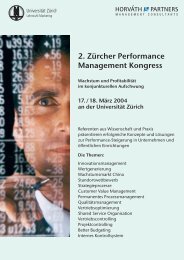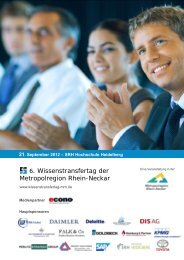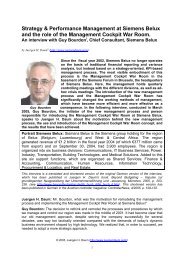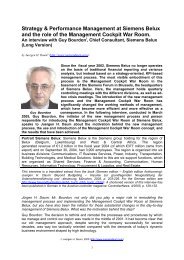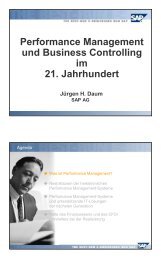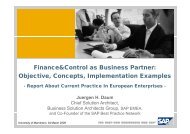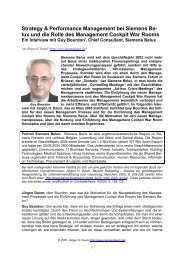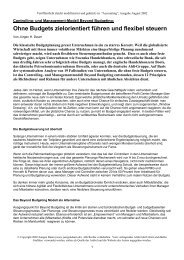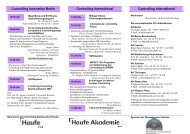“Beyond Budgeting” - Juergen Daum
“Beyond Budgeting” - Juergen Daum
“Beyond Budgeting” - Juergen Daum
Create successful ePaper yourself
Turn your PDF publications into a flip-book with our unique Google optimized e-Paper software.
Successful Enterprise<br />
Management through<br />
Employee Empowerment and<br />
Financial Efficiency:<br />
<strong>“Beyond</strong> <strong>Budgeting”</strong><br />
<strong>Juergen</strong> H. <strong>Daum</strong><br />
SAP AG<br />
Agenda<br />
Motivation for a<br />
New Management System<br />
Company Success Beyond<br />
Traditional Management and<br />
Budgeting:<br />
The Beyond Budgeting Model<br />
Case Studies<br />
Conclusions for HR, Financial,<br />
and IT Management<br />
© SAP AG 2002, SAP HR & Financial Kongress 2002, D7 2<br />
1
Challenges in the Field of<br />
the Leadership Model and<br />
of Organizational<br />
Development<br />
© SAP AG 2002, SAP HR & Financial Kongress 2002, D7 3<br />
Peter F. Drucker:<br />
„Management Challenges for the 21st Century“<br />
“The most important contribution management<br />
needs to make in the 21st century is to<br />
increase the productivity of knowledge work<br />
and of the knowledge worker.<br />
The most valuable asset of a 21st-century<br />
institution, whether business or nonbusiness,<br />
will be its knowledge workers and their<br />
productivity.”<br />
© SAP AG 2002, SAP HR & Financial Kongress 2002, D7 4<br />
2
The New Perspective: Efficiency of Human Capital<br />
Instead of Financial Capital - Case Study SAP*<br />
Financial Capital View<br />
Human Capital View<br />
ROI %<br />
35<br />
23 % 29 %<br />
30<br />
+ 6%<br />
25<br />
200<br />
190<br />
180<br />
Value Added per Person<br />
€ 93,000 € 92,000<br />
€ -1,000<br />
20<br />
170<br />
1994 1995<br />
1994 1995<br />
Improved Fin. Capital Efficiency<br />
Decreased HR Efficiency<br />
*Source: Top Performer Study of The Boston Consulting Group<br />
© SAP AG 2002, SAP HR & Financial Kongress 2002, D7 5<br />
Conclusions<br />
• The most important resource and bottleneck factor for companies like SAP is<br />
not financial capital, but human capital<br />
• Key figure systems that only measure the efficiency of financial capital (such<br />
as EVA) are consequently not sufficient means for steering and for measuring<br />
company performance in a human-capital-intensive business<br />
• “Value added per person” represents a “symptom” in the financial perspective<br />
that cannot be optimized using classic finance-oriented controlling tools<br />
“It is the quality of its structural capital that determines<br />
what a company is able to create from its human capital.”<br />
Leif Edvinsson, pioneer in the field of Intellectual Capital Management*<br />
In this way, the organizational and management systems<br />
become decisive productivity factors!<br />
*Quote taken from an interview with Leif Edvinsson in Jürgen H. <strong>Daum</strong>’s book “Intangible Assets and Value Creation”, Chichester (Wiley) 2002<br />
© SAP AG 2002, SAP HR & Financial Kongress 2002, D7 6<br />
3
Challenges in the Field of<br />
Performance Management<br />
© SAP AG 2002, SAP HR & Financial Kongress 2002, D7 7<br />
Typical Example of Incorrect Business Management<br />
Forecast at a Scandinavian Electronics Group<br />
Production<br />
Quantity<br />
700<br />
600<br />
June, Year 1*<br />
June, Year 2*<br />
Dec, Year 5*<br />
500<br />
Product based on<br />
old technology<br />
400<br />
June, Year 5*<br />
300<br />
June, Year 3*<br />
June, Year 3*<br />
June, Year 4*<br />
June, Year 4*<br />
200<br />
100<br />
Product based on<br />
new technology<br />
June, Year 5*<br />
Actual<br />
Forecast<br />
Year 1 Year 2 Year 3 Year 4 Year 5 Year 6 Year 7 Year 8<br />
* Date when the forecast was drawn up<br />
© SAP AG 2002, SAP HR & Financial Kongress 2002, D7 8<br />
4
Companies Compelled to Develop Extended Operational<br />
Models due to New Competitive Factors<br />
Traditional Industrial<br />
Operational Model<br />
New Operational Model<br />
Product<br />
Developmt<br />
Purchasing<br />
Production<br />
Sales<br />
Customer<br />
Supplier<br />
SRM<br />
SCM<br />
CRM<br />
Customer<br />
“Sellers’ Market”<br />
• Time horizon: Month / quarter<br />
• Relationship between input and output is<br />
more direct<br />
• Resources can be acquired and implemented<br />
at short notice<br />
“Purchasers’ Market”<br />
• Time horizon: Quarter, 1-2 years, 3-5 years<br />
• Relationship between input and output is<br />
more indirect<br />
• More resources have do be developed internally<br />
Management Tools:<br />
- P&L/ Financial Reports<br />
- Cost Accounting<br />
- The corresponding budgets<br />
Consequences:<br />
• Greater complexity<br />
• Business system more dynamic<br />
• Traditional tools insufficient<br />
© SAP AG 2002, SAP HR & Financial Kongress 2002, D7 9<br />
Consequences for enterprises<br />
• Performance targets remain fixed over the planned fiscal year, but the world of<br />
business is ever changing: Companies are often unable to react quickly<br />
enough with adjustment measures<br />
• In budgeting, the short-term perspective is in focus (time horizon: fiscal year).<br />
However, essential value-creating activities (concerning customer relations,<br />
product development projects, etc.) are tied to projects extending over several<br />
years<br />
• Budget mentality prevents managers from surpassing themselves by setting<br />
truly ambitious targets. Really innovative ideas often fail to get past the first<br />
hurdle.<br />
“The budget is the bane of Corporate America. […] It is<br />
an exercise in minimalization. You always are getting the<br />
lowest out of people.”<br />
© SAP AG 2002, SAP HR & Financial Kongress 2002, D7 10<br />
Jack Welsh, former CEO, General Electric*<br />
In this way, traditional budget-oriented performance<br />
management systems become obstacles to performance!<br />
*Quote taken from an interview in Fortune Magazine, 1995<br />
5
The Beyond Budgeting<br />
Management Model<br />
tackles these very issues<br />
© SAP AG 2002, SAP HR & Financial Kongress 2002, D7 11<br />
Agenda<br />
Motivation for a<br />
New Management System<br />
Company Success Beyond<br />
Traditional Management and<br />
Budgeting:<br />
The Beyond Budgeting Model<br />
Case Studies<br />
Conclusions for HR, Financial,<br />
and IT Management<br />
© SAP AG 2002, SAP HR & Financial Kongress 2002, D7 12<br />
6
Basic Principles of Traditional Budgeting<br />
Strategy<br />
• Market and Growth Targets<br />
• Result Targets<br />
• Shareholder Value Targets<br />
Budget<br />
Basis for Target and Resource<br />
Negotiations<br />
Integration of Subplans<br />
Conversion into Financial View<br />
Basis for Internal Agreements/<br />
Basis for Incentives<br />
Resource<br />
Planning<br />
Coordination<br />
of Operative<br />
Subplans<br />
• Financial<br />
Means<br />
• Personnel<br />
• Investments<br />
• ....<br />
• Sales<br />
• Marketing<br />
• Einkauf<br />
• Fertigung<br />
• Entwicklung<br />
• ....<br />
© SAP AG 2002, SAP HR & Financial Kongress 2002, D7 13<br />
Beyond Budgeting<br />
The Beyond Budgeting Model<br />
has two pillars<br />
1. 1. Self-governance<br />
2. 2. Operations managers<br />
are are empowered<br />
3. 3. Responsible for for results<br />
4. 4. Network organization<br />
5. 5. Coordination matching market<br />
6. 6. Management by by coaching<br />
New<br />
Leadership Principles<br />
Management View<br />
7. Relative targets<br />
8. Adaptable strategies<br />
9. Anticipation system<br />
10. Resources as required<br />
11. Rapid and open<br />
information system<br />
12. Relative,<br />
team-oriented<br />
bonus system<br />
New Performance<br />
Management Principles<br />
Controlling View<br />
© SAP AG 2002, SAP HR & Financial Kongress 2002, D7 14<br />
7
The Underlying Philosophy of Beyond Budgeting –<br />
Aspect 1: Achieving Flexible Performance Management<br />
Traditional Performance<br />
Management Model<br />
New Performance<br />
Management Model<br />
(Fixed)<br />
Strategic Plan<br />
(Horizon: 5 Years)<br />
“Take<br />
that hill!”<br />
Adjustments to Strategy<br />
at Shorter Notice<br />
Annual<br />
Budget<br />
Operations<br />
Management<br />
Trapped in<br />
Annual Budget<br />
“The hill<br />
has moved!”<br />
Continual Adjustment<br />
of Operational<br />
Activities<br />
Continual<br />
reconciliation<br />
© SAP AG 2002, SAP HR & Financial Kongress 2002, D7 15<br />
Underlying Principle: Sense and Respond<br />
Traditional Model<br />
(“Make and Sell”)<br />
New Model<br />
(“Sense and Respond”)<br />
Resources<br />
Obtain Required<br />
Resources<br />
Production<br />
Production<br />
Warehouse<br />
Coordinate<br />
Manufacturing<br />
Customer<br />
Customer<br />
© SAP AG 2002, SAP HR & Financial Kongress 2002, D7 16<br />
8
The Underlying Philosophy of Beyond Budgeting –<br />
Aspect 2: Empowerment and Self-Governance<br />
Traditional Model<br />
(“Hierarchy”)<br />
New Model<br />
(“Network”)<br />
“command and control”<br />
“Seeing for oneself, reaching<br />
joint agreements, and making<br />
one’s own decisions”<br />
© SAP AG 2002, SAP HR & Financial Kongress 2002, D7 17<br />
Underlying Principle: System Self-Optimization<br />
Through Local Autonomy<br />
Example of a Self-Optimizing Organization Model:<br />
Anthill Social Organization<br />
Scent trail<br />
Feeding Place A<br />
The system optimizes itself by applying two simple<br />
rules at the individual / local level:<br />
1. “Leave a scent trail during the search”<br />
2. “Follow the most recent/strongest scent trail”<br />
Feeding Place B<br />
© SAP AG 2002, SAP HR & Financial Kongress 2002, D7 18<br />
9
CAM-I BBRT’s Beyond Budgeting Framework<br />
Company<br />
Environment<br />
Success<br />
Factors<br />
Devolutionary<br />
Framework<br />
Management<br />
Processes<br />
Investors Demand<br />
Better performance<br />
Adaptability /<br />
Speed of Reaction<br />
1 Governance<br />
7 Targets<br />
Lack of Talent<br />
Talented<br />
Manager/Employees<br />
2 Challenge&Values<br />
8 Incentives<br />
Growing Rate of<br />
Innovation<br />
Continual<br />
Innovation<br />
3 Accountability<br />
9 Strategy<br />
Global Competition/<br />
Market Depression<br />
Operational<br />
Excellence<br />
4 Empowerment<br />
10 Resources<br />
Customers’ Freedom<br />
to Choose<br />
Orientation to the<br />
Customer<br />
5 Organization<br />
11 Coordination<br />
Higher Ethical<br />
and Social Demands<br />
Sustainable<br />
Performance<br />
6 Transparency<br />
12 Measurement<br />
© SAP AG 2002, SAP HR & Financial Kongress 2002, D7 19<br />
The Framework: The 12 Principles of Beyond Budgeting<br />
New Leadership Vision /<br />
Management Principles<br />
1. Create a performance climate<br />
based on competitive success<br />
2. Motivate people by offering them<br />
challenge, responsibility, clear values<br />
and shared reward<br />
3. Devolve performance responsibility to<br />
operating managers; give them the<br />
freedom to decide<br />
4. Empower operational managers by giving<br />
them the capability to act (i.e. Access to<br />
Resources) and to Take Autonomous Action<br />
5. Organize around customer-oriented teams<br />
that are accountable for profitable<br />
customer outcomes<br />
6. Support transparent and open information<br />
systems that provide “one truth”<br />
throughout the organization<br />
New Finance Vision /<br />
Performance Management<br />
7. Goal-Setting Process based on<br />
agreed external benchmarks<br />
8. Motivation and Reward Process<br />
focused on team based<br />
competitive success<br />
9. Strategy and Action Planning Process<br />
Devolved to operating managers /<br />
made continuous<br />
10. Resource utilization process<br />
based on local access to resources<br />
within agreed parameters<br />
11. Coordination Process based on cross<br />
company interactions through<br />
market like forces<br />
12. Measurement and Control Process<br />
based on fast, open and<br />
distributed multilevel control<br />
© SAP AG 2002, SAP HR & Financial Kongress 2002, D7 20<br />
10
Agenda<br />
Motivation for a<br />
New Management System<br />
Company Success Beyond<br />
Traditional Management and<br />
Budgeting:<br />
The Beyond Budgeting Model<br />
Case Studies<br />
Conclusions for HR, Financial,<br />
and IT Management<br />
© SAP AG 2002, SAP HR & Financial Kongress 2002, D7 21<br />
Case Study: Svenska Handelsbanken<br />
• No budgets (since 1970)<br />
• No absolute targets<br />
• No fixed plans<br />
• No central marketing<br />
• No product orientation<br />
• No individual incentives<br />
• Virtually no hierarchies...<br />
… and nevertheless one of the most successful banks in Europe. Moreover, for the<br />
past 30 years, it has repeatedly beaten all Scandinavian competitors in terms of all<br />
essential performance measurements (ROE*, TSR*, EPS*, cost/income, and customer<br />
satisfaction).<br />
Svenska Handelbanken is the most cost-efficient bank in Europe. Reasons:<br />
• Costs constantly examined by all employees, and<br />
• Exceptionally low losses on receivables because credit decisions are only made at local level<br />
where the customer is known<br />
*ROE= return on equity, TSR = total shareholder return, EPS = earnings per share<br />
© SAP AG 2002, SAP HR & Financial Kongress 2002, D7 22<br />
11
The Organizational Structure<br />
Customers<br />
•<br />
•<br />
Focus<br />
Focus<br />
on<br />
on<br />
customer,<br />
customer,<br />
not<br />
not<br />
on<br />
on<br />
products<br />
products<br />
•<br />
•<br />
All<br />
All<br />
customers<br />
customers<br />
“belong”<br />
“belong”<br />
to<br />
to<br />
a<br />
a<br />
specific<br />
specific<br />
branch<br />
branch<br />
•<br />
•<br />
Customer<br />
Customer<br />
profitability<br />
profitability<br />
is<br />
is<br />
permanently<br />
permanently<br />
monitored<br />
monitored<br />
567 Branch<br />
Managers<br />
•<br />
•<br />
Decision-making<br />
Decision-making<br />
about<br />
about<br />
customers,<br />
customers,<br />
solutions,<br />
solutions,<br />
and<br />
and<br />
prices<br />
prices<br />
•<br />
•<br />
Responsibility<br />
Responsibility<br />
for<br />
for<br />
branch<br />
branch<br />
personnel<br />
personnel<br />
and<br />
and<br />
results<br />
results<br />
•<br />
•<br />
Their<br />
Their<br />
principal<br />
principal<br />
key<br />
key<br />
figure<br />
figure<br />
is<br />
is<br />
cost/income<br />
cost/income<br />
10 Regional<br />
Managers<br />
CEO<br />
Product, Companies,<br />
Treasury, IT, etc.<br />
•<br />
•<br />
Decision-making<br />
Decision-making<br />
about<br />
about<br />
regional<br />
regional<br />
strategy<br />
strategy<br />
(such<br />
(such<br />
as<br />
as<br />
concerning<br />
concerning<br />
the<br />
the<br />
opening<br />
opening<br />
and<br />
and<br />
closure<br />
closure<br />
of<br />
of<br />
branches)<br />
branches)<br />
•<br />
•<br />
Responsibility<br />
Responsibility<br />
for<br />
for<br />
support<br />
support<br />
units<br />
units<br />
•<br />
•<br />
Their<br />
Their<br />
aim<br />
aim<br />
is<br />
is<br />
to<br />
to<br />
beat<br />
beat<br />
the<br />
the<br />
overall<br />
overall<br />
ROE<br />
ROE<br />
of<br />
of<br />
the<br />
the<br />
bank<br />
bank<br />
and<br />
and<br />
that<br />
that<br />
of<br />
of<br />
the<br />
the<br />
other<br />
other<br />
regions<br />
regions<br />
•<br />
•<br />
Definition<br />
Definition<br />
of<br />
of<br />
the<br />
the<br />
values<br />
values<br />
and<br />
and<br />
principles<br />
principles<br />
of<br />
of<br />
the<br />
the<br />
company<br />
company<br />
•<br />
•<br />
Development<br />
Development<br />
of<br />
of<br />
an<br />
an<br />
environment<br />
environment<br />
of<br />
of<br />
top-down<br />
top-down<br />
challenges<br />
challenges<br />
and<br />
and<br />
local<br />
local<br />
stretch<br />
stretch<br />
targets<br />
targets<br />
•<br />
•<br />
Measurement<br />
Measurement<br />
of<br />
of<br />
the<br />
the<br />
bank’s<br />
bank’s<br />
ROE<br />
ROE<br />
compared<br />
compared<br />
to<br />
to<br />
that<br />
that<br />
of<br />
of<br />
other<br />
other<br />
Scandinavian<br />
Scandinavian<br />
banks<br />
banks<br />
• Streamlined HQ (300 employees in 2000, compared to 1500 in 1970)<br />
• Ratio of 0.5 HQ employees per branch (compared to average of 5<br />
employees per branch among the bank’s competitors)<br />
© SAP AG 2002, SAP HR & Financial Kongress 2002, D7 23<br />
The Management and Controlling System at<br />
Svenska Handelsbanken<br />
•No formal strategy process<br />
•No year plan or budgets<br />
1. Clear values form the framework<br />
•Budgeting replaced by an accounting<br />
and information system<br />
2. Management process on informal basis: Top managers meet in monthly<br />
meetings without an agenda, discussions are based on the profit center figures.<br />
Aim: To exchange information and ideas and to discuss possible measures to correct<br />
negative trends<br />
3. Performance measurement and incentive system: Performance is always<br />
measured in relation to the competition. Measurement involves few key figures:<br />
ROE (group), ROE + cost / income (region), cost / income + result per employee<br />
(branch). Annual competition at regional level for the branch with best results.<br />
Capital is allocated to the regions annually on the basis of the performance of each<br />
region. Branch performance constantly monitored, involving all employees. Bonuses<br />
are not awarded to individual employees, but are determined instead on the basis of<br />
group performance.<br />
© SAP AG 2002, SAP HR & Financial Kongress 2002, D7 24<br />
12
Case Study: Boots<br />
© SAP AG 2002, SAP HR & Financial Kongress 2002, D7 25<br />
Case Study: Boots (Boots Healthcare International)*<br />
• No fixed budgets<br />
• Continuous reforecasting<br />
• No fixed planning<br />
“… the highly flexible performance management at Boots makes it easier to<br />
meet the group’s overall targets ”<br />
* Based on a presentation by Matthias Steinke, Head of Accounting and Controlling for BHI (Boots Healthcare International) and Hermal Kurt<br />
Hermann GmbH&Co OHG, held at the <strong>“Beyond</strong> <strong>Budgeting”</strong> seminar for the Management Circle AG, chaired by the speaker on 07/31/2002 in Cologne.<br />
© SAP AG 2002, SAP HR & Financial Kongress 2002, D7 26<br />
13
The Management and Controlling System at<br />
Boots Healthcare International<br />
• No fixed budget for the fiscal year<br />
• Constant forecasts to assess goal achievement / results on ad hoc basis<br />
• Continuous adjustment of plans for the entire region of operations<br />
1. Fixed Performance Contract with the Boots Group<br />
(based on few KPIs: Sales / Profit / Cash Flow / Economic Profit / Value for the<br />
following 5 years, updated annually, bottom-up annual budgets are drawn up once<br />
and are then overridden by the forecasts)<br />
2. Management and controlling process is oriented towards these<br />
jointly-determined targets but still remains very flexible: Continuous<br />
assessment of goal achievement, continuous adjustment and coordination of<br />
measures right across the region (using format of regular management meetings<br />
between SPC managers from the region and the global category managers →<br />
“trade-off process”)<br />
3. Continuous forecasts form basis for controlling: Each opportunity or<br />
threat to business at the local level generates a new forecast (Poland spared wave<br />
of flu, new health policies implemented in Germany, and so on)<br />
© SAP AG 2002, SAP HR & Financial Kongress 2002, D7 27<br />
Agenda<br />
Motivation for a<br />
New Management System<br />
Company Success Beyond<br />
Traditional Management and<br />
Budgeting:<br />
The Beyond Budgeting Model<br />
Case Studies<br />
Conclusions for HR, Financial,<br />
and IT Management<br />
© SAP AG 2002, SAP HR & Financial Kongress 2002, D7 28<br />
14
Points to Consider When Implementing<br />
<strong>“Beyond</strong> <strong>Budgeting”</strong><br />
• There is no out-of-the-box Beyond Budgeting solution<br />
that companies can implement<br />
• For the implementation, focus needs to be on individual<br />
Beyond Budgeting principles, dependent on the<br />
individual success factors specific to a company<br />
• Management models are more difficult to change and it<br />
takes longer than making improvements in the area of<br />
Performance Management. However, the effect is longerlasting<br />
• Applying Beyond Budgeting to the performance<br />
management system is easier, especially if it is done<br />
through a step-by-step approach to making the<br />
performance management processes and procedures (in<br />
the enterprise management system) more flexible<br />
© SAP AG 2002, SAP HR & Financial Kongress 2002, D7 29<br />
System for Performance Management,<br />
Business Controlling, and<br />
Strategy Management<br />
© SAP AG 2002, SAP HR & Financial Kongress 2002, D7 30<br />
15
Elements of the New Enterprise Management System*<br />
Extended Performance<br />
Measurement<br />
for “Multi-Level Control”<br />
Strategy<br />
Implementation<br />
and Overall<br />
Performance<br />
Product<br />
Development<br />
and Marketing<br />
Operational<br />
Business<br />
Markets /<br />
Customers<br />
Balanced Scorecard<br />
Financial<br />
Results<br />
Strategic<br />
Projects<br />
Processes /<br />
Resources<br />
Product Innovation Cockpit<br />
Market<br />
Research<br />
Development<br />
of New<br />
Products<br />
and Services<br />
Operational Cockpits<br />
Fulfillment /<br />
SCM Cockpit<br />
Creation of a balanced and highly<br />
focussed view of all strategic and<br />
operational success factors<br />
Marketing,<br />
Business<br />
Development<br />
CRM<br />
Cockpit<br />
Resource<br />
Resource Management Cockpits<br />
Management HR IT Alliances Finances<br />
Goal Setting<br />
Performance<br />
Measurement<br />
Continual Management<br />
Processes for Dynamic<br />
Adaptability<br />
Creation of Value (of Potential for the Future)<br />
and of Long-Term Competitive Advantages<br />
Strategy<br />
Adjustment<br />
Strategy Management<br />
Process<br />
Forecast<br />
Performance Management<br />
Process<br />
Process<br />
Adjustment<br />
Strategic<br />
Analysis<br />
Define<br />
Adjustment<br />
Method<br />
Achievement of Short-Term Performance<br />
Targets and Realization of Generated Values<br />
Integrated, rolling management processes<br />
enable strategies to be linked to the business<br />
processes and daily operations<br />
*see: Jürgen <strong>Daum</strong>: “Intangible Assets and Value Creation”, Chichester (Wiley) 2002<br />
© SAP AG 2002, SAP HR & Financial Kongress 2002, D7 31<br />
Rolling Forecasts and the Continuous and Systematic<br />
Analysis of New, Emerging Opportunities and Risks<br />
160<br />
140<br />
120<br />
100<br />
80<br />
60<br />
40<br />
Potential<br />
Negative Effects<br />
(New Risks)<br />
Exchange<br />
Rates<br />
Development<br />
Problem<br />
Delays<br />
Project<br />
Uncollectible<br />
receivables<br />
Potential<br />
Positive Effects<br />
(New Opportunities)<br />
Drop in<br />
Price of<br />
Raw<br />
Materials<br />
Income<br />
from<br />
Security<br />
Transactions<br />
Customer<br />
Project<br />
Completed<br />
Ahead of<br />
Schedule<br />
20<br />
0<br />
Previous<br />
Forecast / Budget<br />
Warranty<br />
Sale of<br />
Product A<br />
Surpasses<br />
Forecast<br />
New<br />
Forecast<br />
Source: Jürgen <strong>Daum</strong>: “Intangible Assets and Value Creation”, Chichester (Wiley) 2002<br />
© SAP AG 2002, SAP HR & Financial Kongress 2002, D7 32<br />
16
Dialog-Based Management Systems to Support <strong>“Beyond</strong><br />
<strong>Budgeting”</strong>: Leverage Opportunities and Limit Risks<br />
Actuals<br />
Actual Data and<br />
Facts about<br />
Current and<br />
Past Situation<br />
Dialog-Based<br />
Management<br />
Processes<br />
• Achieve a Common Understanding about<br />
Realistic Opportunities and Possible Future<br />
Scenarios<br />
• Agree on Measures<br />
• Communicate to all Stakeholders<br />
• Review and Adjust Planned Measures Regularly<br />
Forecast<br />
Opinions on Future<br />
Potential and Risks<br />
The corresponding management processes are supported by instruments such as:<br />
Rolling Forecasts, Scenario Planning, Systems Thinking<br />
© SAP AG 2002, SAP HR & Financial Kongress 2002, D7 33<br />
Information Systems<br />
© SAP AG 2002, SAP HR & Financial Kongress 2002, D7 34<br />
17
Focus of IT Support for a <strong>“Beyond</strong> <strong>Budgeting”</strong> Concept<br />
for Enterprise Management<br />
“Fast Actuals”<br />
• Rapid delivery of reliable and relevant key figures concerning:<br />
Overall success<br />
(such as Profit, EVA, ROE ...)<br />
Important value-creation activities / value drivers<br />
(such as customer acquisition / customer churn rate / customer profitability, risk profile of<br />
customer base, asset management result, employee productivity ...)<br />
• Also encompasses “Fast Close”<br />
Flexible, ad hoc forecasting with immediate transparency for all areas of the<br />
company<br />
• A company-wide planning database accessible for all managers and controllers<br />
• As far as possible, any additional calculations are performed in the same system<br />
and are based on a uniform dataset<br />
• The “base case” that is usually interlinked with potential or already implemented<br />
additional measures, will remain transparent (precondition for flexibility!)<br />
• Storage of structured and unstructured information (comments, documents, links to<br />
Web pages, and so forth)<br />
© SAP AG 2002, SAP HR & Financial Kongress 2002, D7 35<br />
SEM/BA: Efficient Forecasting Process Using Uniform<br />
Planning Procedure and a Consistent Data Basis<br />
3. Updates Using Plans<br />
2. Forecast Completion<br />
1. Simulation<br />
BW<br />
+ SEM<br />
© SAP AG 2002, SAP HR & Financial Kongress 2002, D7 36<br />
18
Architecture of the Information Supply System<br />
Operational<br />
Systems<br />
(Business) Accounting<br />
Analytical World<br />
System 1<br />
(Internal)<br />
Planning<br />
System 2<br />
(Internal)<br />
System 3<br />
(Partner)<br />
System 4<br />
(Partner)<br />
Accounting Engine /<br />
Accounting Factory<br />
Data Warehousing<br />
Reporting<br />
Analysis /<br />
DSS<br />
Manager<br />
Portals<br />
• Flexibility Within<br />
Each Business<br />
Process<br />
• Mostly Free of<br />
Accounting<br />
Semantics<br />
• “Fast Close” due to High<br />
Level of Automation and<br />
Centralization<br />
• Consistency, Parallel Views of<br />
Financial Data (such as IAS,<br />
Local, Management View)<br />
• Uniform Data Basis for Planning,<br />
Reporting, and Analysis<br />
• User-Oriented Flexibility<br />
• Optimized for Analysis and<br />
Decision-Support<br />
© SAP AG 2002, SAP HR & Financial Kongress 2002, D7 37<br />
Strategic Information Capital Readiness Map<br />
(Consumer Bank Example)<br />
Strategic<br />
Programs<br />
Strategic<br />
Jobs<br />
Innovation Customer Management Operational Excellence<br />
Understand Develop<br />
Cross-Sell Shift to<br />
Provide<br />
Customer<br />
New<br />
the Product Appropriate<br />
Minimize<br />
Rapid<br />
Segments Products<br />
Line<br />
Channel<br />
Problems<br />
Response<br />
Consumer<br />
Marketer<br />
Joint Venture<br />
Manager<br />
Certified Telemarketer<br />
Financial Planner<br />
Quality<br />
Manager<br />
Call Center<br />
Representative<br />
Strategic<br />
Information<br />
Capital<br />
Portfolio<br />
Applications<br />
for Business<br />
Analytics<br />
Applications<br />
for Transaction<br />
Processing<br />
• Customer<br />
Profitability<br />
Systems<br />
(CPS)<br />
• Customer<br />
Feedback<br />
System<br />
(CFS)<br />
• Best Practice<br />
Community<br />
(BPC)<br />
• Project<br />
Management<br />
System<br />
(PMS)<br />
• Portfolio<br />
Planning<br />
Models<br />
(PPMs)<br />
• Integrated<br />
Customer<br />
File (ICF)<br />
• Integrated<br />
Customer<br />
File (ICF)<br />
• Order<br />
Management<br />
System(OMS)<br />
• Sales Force<br />
Automation<br />
(SFA)<br />
• Incident<br />
Tracking<br />
System<br />
(ITS)<br />
• Problem<br />
Management<br />
System<br />
(PRMS)<br />
• Working<br />
Scheduling<br />
System<br />
(WSS)<br />
• Problem<br />
Management<br />
System<br />
(PRMS)<br />
Technology<br />
Infrastructure<br />
CRM Packaged Software (CRM)<br />
Web-Enabled (WEB) Interactive Voice Response<br />
(IVR)<br />
Computer Telephony Integration (CTI)<br />
Strategic<br />
IC Readiness<br />
Rating<br />
Total Number<br />
of #4,#5,#6<br />
Ratings:<br />
© SAP AG 2002, SAP HR & Financial Kongress 2002, D7 38<br />
CPS<br />
CFS<br />
3<br />
2<br />
BPC<br />
PMS<br />
2<br />
2<br />
PPMs<br />
ICF 2<br />
LED 6 ITS 6 WSS 3<br />
OMS 2 PRMS 2 PRMS 2<br />
SFA 4<br />
6<br />
CRM 2<br />
WEB<br />
CRM<br />
3<br />
2<br />
WEB<br />
CTI<br />
3<br />
4<br />
WEB<br />
CTI<br />
3<br />
4<br />
IVR<br />
CTI<br />
3<br />
4<br />
Key: 1 OK 2 Minor Enhancements 3 New Development (Started) 4 New Development (Behind Schedule)<br />
5 Considerable Enhancement Necessary (Not Yet Started) 6 New Development Necessary (Not Yet Started)<br />
19
Personnel Management<br />
© SAP AG 2002, SAP HR & Financial Kongress 2002, D7 39<br />
Creating the Right Environment to make People<br />
really productive<br />
• Empowerment motivates, but only if it can be lived out for real<br />
• A management style entailing a careful balance between<br />
coaching and setting challenges helps employees to realize their<br />
full potential<br />
• Hiring employees who can be trusted with responsibilities and<br />
who enjoy having them, and who are not trapped in the classical<br />
hierarchy mindset<br />
• Prioritize internal resources for filling management positions?<br />
© SAP AG 2002, SAP HR & Financial Kongress 2002, D7 40<br />
20
Human Capital Development Program<br />
• Which competencies and skills do we need in future?<br />
• Do the employees lend their full support to the company’s goals?<br />
• Is team spirit sufficiently present?<br />
Human Capital Readiness Map<br />
Human Capital<br />
Category<br />
Aim<br />
Target Value<br />
Human Capital<br />
Development Program<br />
Strategic<br />
Competencies<br />
Management<br />
Alignment /<br />
Motivation<br />
• Reduce<br />
Strategic<br />
Talent Gap<br />
• Reduce<br />
Fluctuation<br />
• Manager<br />
Competence<br />
• Acceptance<br />
Among<br />
Employees<br />
• Employees<br />
Actively<br />
Support<br />
Company<br />
Goals<br />
• < 10%<br />
• < 5%<br />
• Rating based<br />
on Job<br />
Requirements<br />
• Rating in<br />
Peer Group<br />
• Employee<br />
Survey<br />
• Ratings by<br />
Other<br />
Stakeholders<br />
HR Function<br />
Recruiting<br />
Training &<br />
Development<br />
Leadership<br />
Development<br />
Communications<br />
/ Change<br />
Management<br />
Measures<br />
Target<br />
Integration<br />
Energy /<br />
Team Spirit<br />
• Sharing<br />
Knowledge,<br />
Experts,<br />
etc.<br />
• Employee<br />
Survey<br />
• Manager<br />
Survey<br />
Knowledge<br />
Management<br />
© SAP AG 2002, SAP HR & Financial Kongress 2002, D7 41<br />
Decentralization of Responsibility Calls for<br />
a Strong Company Charter<br />
Example: Supplier in Automobile Industry with Decentralized Structures<br />
Company Charter<br />
Employee Charter:<br />
• Fairness<br />
• Job Security<br />
• Competitive Salaries<br />
• Employee own a share in the<br />
company’s stock<br />
• Communication and<br />
Information<br />
• Personal Hotline Support<br />
Underlying Principles:<br />
• Values and Basic Rules (What<br />
We Do and Don’t Do)<br />
• Mission: What We Are About<br />
• Target Distribution Key for<br />
Company Profit<br />
Reinvestment<br />
and Taxes<br />
55%<br />
Stakeholders<br />
20%<br />
Management<br />
6%<br />
R&D<br />
7%<br />
Social Aims<br />
2%<br />
Employees<br />
10%<br />
Incentive System:<br />
• Employee Profit-Sharing<br />
(50% Cash / 50% Stocks)<br />
• Incentives Linked to Continual<br />
Improvement Process<br />
• Incentives for Middle<br />
Management based on<br />
Annual Target Agreements<br />
• Top Management: 3-Year<br />
Share in Company Stocks with<br />
Obligatory Period of Retention<br />
– Use of Resources: Employee<br />
Involvement in Assessment<br />
Process<br />
© SAP AG 2002, SAP HR & Financial Kongress 2002, D7 42<br />
21
Closing Thoughts<br />
• For Controlling:<br />
- Relevance beats completeness, speed beats accuracy!<br />
- How should a people-oriented controlling concept look?<br />
- Consequences for the organization of a company’s controlling area:<br />
Should we perhaps be thinking about a more interdisciplinary approach<br />
beyond a pure financial view?<br />
• For IT Management:<br />
- “Disciplining the enduser” vs. “personal productivity”<br />
- IT as a specialist or a generalist discipline?<br />
- How to bridge the gap between “Strategic Readiness” and “Operational<br />
Efficiency”?<br />
• For Personnel Management:<br />
- Personnel manager = Administrator or productivity manager?<br />
- From personnel manager to specialist for structural capital / organization?<br />
- How do you gain the necessary influence on the business? What is your<br />
strategy? (Can you learn something from the controllers?)<br />
© SAP AG 2002, SAP HR & Financial Kongress 2002, D7 43<br />
Thank you for your attention<br />
and your interest!<br />
© SAP AG 2002, SAP HR & Financial Kongress 2002, D7 44<br />
22
More Information about Beyond Budgeting<br />
• Links<br />
http://www.cam-i.org/bb.html<br />
http://www.juergendaum.com/bb.htm<br />
• Background Information on the New Enterprise Management System:<br />
Jürgen <strong>Daum</strong>’s Website at<br />
• http://www.juergendaum.com/<br />
Jürgen <strong>Daum</strong>’s book:<br />
Intangible Assets<br />
and Value Creation<br />
by <strong>Juergen</strong> H. <strong>Daum</strong><br />
John Wiley & Sons, Chichester, 2002<br />
ISBN 04708455120<br />
(available 19 December 2002)<br />
More information at:<br />
http://www.juergendaum.com/mybook.htm<br />
© SAP AG 2002, SAP HR & Financial Kongress 2002, D7 45<br />
23




